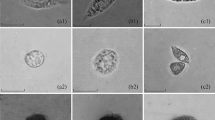Summary
Callianassa, an estuarine animal, can experience changes in salinity which reduce the level of divalent cations in the blood, as well as changes in temperature and variations in protein concentration in the hemolymph. The hemocyanin in whole hemolymph shows evidence of dissociation (∼ 12%) after 3 days acclimation to 40% seawater. Using purified hemocyanin the dissociation from 39 S to 17 S hemocyanin was investigated for the three variables, salinity, temperature and protein concentration. An equation was developed to define the amount of dissociation which should be observed under physiological conditions.
Similar content being viewed by others
References
Arisaka F, Holde KE Van (1979) Allosteric properties and the association equilibria of hemocyanin fromCallianassa californiensis. J Mol Biol 134:41–73
Blair D, Holde KE Van (1976) Sedimentation equilibrium studies of a complex association reaction. Biophys Chem 5:165–170
Holde KE Van, Blair D, Eldred N, Arisaka F (1977) Association equilibria ofCallianassa hemocyanin. In Bannister JV (ed) Structure and function of haemocyanin. Springer, Berlin Heidelberg New York
Mangum CP (1981a) The influence of inorganic ions and pH on HcO2 transport system. In: Lamy J (ed.) Invertebrate oxygen binding proteins — structure, function and active site. Dekker, New York (in press)
Mangum CP (1981b) Oxygen transport in the blood. In: Mantel LH (ed.) Biology of crustacea, vol II. Academic Press, New York (in press)
Mangum CP, Towle DW (1977) Physiological adaptation to unstable environments. Am Sci 65:67–75
Miller KI, Holde KE Van (1981) The effect of environmental variables on the structure and function of hemocyanin fromCallianassa californiensis. I. Oxygen binding. J Comp Physiol 143:253–260
Roxby R, Miller K, Blair DP, Holde KE Van (1974) Subunits and association equilibria ofCallianassa californiensis hemocyanin. Biochemistry 13:1662–1668
Schachman HS (1959) Ultracentrifugation in biochemistry. Academic Press, New York, p 122
Thompson LC, Pritchard AW (1969) Osmoregulatory capacities ofCallianassa andUpogebia (Crustacea: Thalassinidea). Biol Bull 136:114–129
Thum AB (1972) An ecological study ofDiatomovora amoena, an interstitial acoel flatworm, in an estuarine mudflat on the central coast of Oregon. PhD thesis, Oregon State University
Weiland AL, Mangum CP (1975) The influence of environmental salinity on hemocyanin function in the blue crab,Callinectes sapidus. J Exp Zool 193:265–273
Author information
Authors and Affiliations
Rights and permissions
About this article
Cite this article
Miller, K.I., Van Holde, K.E. The effect of environmental variables on the structure and function of hemocyanin fromCallianassa californiensis . J Comp Physiol B 143, 261–267 (1981). https://doi.org/10.1007/BF00797706
Accepted:
Issue Date:
DOI: https://doi.org/10.1007/BF00797706




